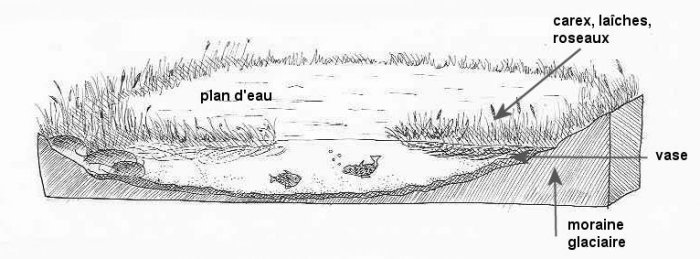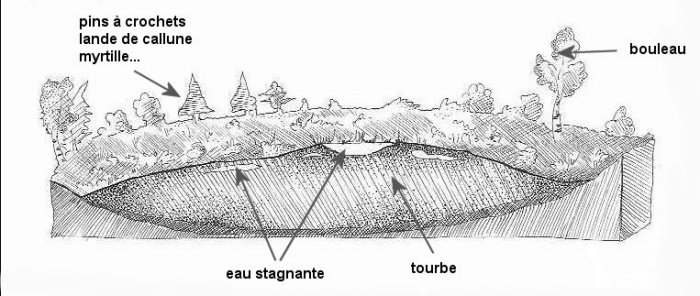Biologique
Les tourbières couvrent seulement 0,1
% du territoire français,
pourtant elles abritent 9
% des plantes protégées en France et
une grande diversité d’espèces animales.
• libellules
• grenouilles
• reliques glaciaires
• plantes carnivores
Tourbière de l'étang de la Comtesse L'accumulation progressive de débris végétaux dans un milieu gorgé d'eau sous un climat frais et humide, après plusieurs siècles a formé un écosystème fragile, la tourbière. Parmi les végétaux poussent les mousses et les joncs, les plantes carnivores, ..., dont les résidus après plusieurs siècles forment la tourbe. La tourbe n'est pas un engrais mais sa forte teneur en matière organique en fait un très bon combustible. Un bloc de tourbe brûle comme du charbon. Les matières organiques végétales et animales sont conservées couches par couches dans les tourbières. Le froid et l'humidité sont défavorables à une vie microbienne et les matières organiques ne se décomposent pas. Ainsi les pollens, graines, coquilles... tous restent intact. Ils se sont déposés année après année et nous informent aujourd'hui sur les végétations successives de la tourbière et de ses environs. L'étang de la Comtesse possède une des rares tourbières de plaine. Elle est gérée par le conservatoire des sites lorrains et appartient à la commune de Sanchey. Sa superficie est de 1 hectare environ pour une longueur de 400 m et une largeur de 50 m. Parce que cet étang de pisciculture a été abandonné depuis de nombreuses années et que le niveau de l'eau a légèrement baissé alors, en amont, une tourbière acide a pu se former. Ainsi une faune et une flore typiques de cet écosystème se sont développées à l'extrémité de l'étang. L'accès à la tourbière est libre et aménagé pour permettre une approche plus facile du milieu sans le détériorer. La faune est représentée par les batraciens et les insectes mais aussi par toute la faune des bois qui entoure l'étang. La flore est très riche outre la végétation propre aux étangs comme les nénuphars, les mousses, les ajoncs, ... Cependant la flore la plus remarquable est représentée par une petite plante carnivore.
UNE TOURBIÈRE, QU'EST-CE QUE C'EST ?
| LES TYPES DE TOURBIÈRES |
|
Notre région possède les conditions nécessaires à la formation des tourbières :
- apports en eau (précipitations, ruissellement) supérieurs aux pertes (évapotranspiration, écoulements).
- importance de la topographie (dépression, présence de dolines : détournement des eaux de ruissellement).
- imperméabilité du sol (couche isolante) avec eau non calcaire indispensable.
|
6 000 ans av. J.-C. - Tourbière à carex ou bas-marais

Étape 1 :
Comblement progressif de la dépression par les végétaux non spécialisés (laîches, roseaux). C'est la formation de la tourbière de bas-marais appelée encore tourbière à carex. Cette étape permet d'isoler la zone des contaminations en eaux calcaires.
3 000 av. J.-C. - Tourbière "vivante"

Étape 2 :
Suite à une accumulation des eaux de pluie légèrement acides à la surface de la tourbière à carex, apparition de mousses "avides d'acidité" (les sphaignes), dont le développement en hauteur aboutit à l'épaississement de la tourbière. Cette phase de croissance des sphaignes caractérise la tourbière vivante. Ces eaux acides sont quasiment exemptes de bactéries.
1 000 ans av. J.-C. à nos jours - Tourbière "morte" ou bombée

Étape 3 : Lorsque l'épaisseur de la tourbe empêche les mousses de puiser de l'eau, le bombement cesse, c'est alors que s'installent les végétaux tels que la callune et la myrtille. On parle de tourbière morte ou bombée. La présence de ces végétaux, qui sont habituellement inféodés à des milieux secs, est due à la relative indisponibilité de l'eau retenue prisonnière par les sphaignes. Cela forme une lande. En fin d'évolution peuvent apparaître quelques arbres, des pins à crochet, ainsi que des bouleaux à la suite de perturbations du milieu. L'étude des pollens (palynologie) permet de retracer l'histoire de la végétation, les successions climatiques et même l'histoire de l'activité humaine (défrichement du néolithique : plus de pollens de graminées que de pollens d'arbres).

1 Comment avance sur l'eau le comaret des marais?
2 Que fait émerger en surface de l'eau l'utriculaire ?
3 Combien d'éspeces de Drosera peut on trouver ?
4 Estimez la longueur de la digue
Vous pouvez envoye vos réponses par mail et loguer votre découvèrte sans attendre me réponse
Mais tout log sans envoi des réponses sera retiré
A BOG, WHAT IS IT?
TYPES OF BOGS
Our region has the necessary conditions for the formation of peatlands:
water inputs (precipitation, runoff) outweigh the losses (evapotranspiration, runoff).
importance of topography (depression, presence of sinkholes: diversion of runoff).
impermeability of the soil (insulating layer) with soft water essential.
biological Peatlands cover only 0.1% Of French territoire, yet They are home to 9% Of protected plants in France and a wide Variety of animal species. • dragonflies • frogs • glacial relict • carnivorous plants Bog Pond Countess The Gradual accumulation of plant debris in a waterlogged in a cool, moist climate, environment After several centuries FORMED a delicate ecosystem, the bog. Among the plants grow moss and rushes, carnivorous plants, ... Whose on residues form After several centuries peat. Peat is not a fertilizer, ict aim high organic matter is glad of a very good fuel. A block of peat burns like coal. Plant and animal organic material layer by layer are preserved in bogs. Cold and moisture are unfavorable to microbial life and organic materials do not decompose. And pollen, seeds, shells ... all REMAIN intact. They filed Every year and inform us today on successive vegetation of the bog and Its surroundings. The pond of the Countess HAS uncommon lowland bogs. It is managed by the conservatory Lorraine websites and belongs to the municipality of Sanchey. Its area is about 1 hectare to a length of 400 m and a width of 50 m. Because this fish pond has-been abandoned for Many Years and que le water level dropped HAS Slightly acid bog while upstream Could Be FORMED. And fauna and flora typical of this ecosystem-have Developed at the end of the pond. Access to the bog is free and Arranged to allow an easier approach sans Damaging the environment. The fauna is représentée by amphibians and insects goal aussi by all the wildlife of the woods surrounding the pond. The flora is very rich off the clean ponds as water lilies, mosses, gorse vegetation ... But The Most remarkable flora is a small représentée by carnivorous plant. </ P>
Organic </ div> Peatlands cover only 0.1 </ div> % of French territory, </ div> yet they are home to 9 </ div>
% of protected plants in France and </ div> a wide variety of animal species </ div>. • dragonflies </ div> • frogs </ div> • glacial relics </ div> • carnivorous plants </ div> Bog Pond Countess The gradual accumulation of plant debris in a waterlogged in a cool, moist climate, environment after several centuries formed a fragile ecosystem, the bog. Among the plants grow moss and rushes, carnivorous plants, ..., whose residues form after several centuries peat. Peat is not a fertilizer, but its high content of organic matter is a very good fuel. A block of peat coal burns like. Plant and animal organic material layer by layer are preserved in bogs. Cold and moisture are unfavorable to microbial life and organic materials do not decompose. And pollen, seeds, shells ... all remain intact. They filed every year and inform us today on successive vegetation of the bog and its surroundings. The pond of the Countess has a rare lowland bogs. It is managed by the conservatory Lorraine sites and belongs to the municipality of Sanchey. Its area is about 1 hectare to a length of 400 m and a width of 50 m. Because this fish pond has been abandoned for many years and that the water level has dropped slightly while upstream bog acid could be formed. And fauna and flora typical of this ecosystem have developed at the end of the pond. Access to the bog is free and arranged to allow an easier approach without damaging the environment. The fauna is represented by amphibians and insects but also by all the wildlife of the woods surrounding the pond. The flora is very rich off the clean ponds as water lilies, mosses, gorse vegetation ... But the most remarkable flora is represented by a small carnivorous plant.
A BOG, WHAT IS IT? </ font> </ font > </ p>
| TYPES OF BOGS </ font> </ td> </ tr> |
|
Our region has the necessary conditions for the formation of peatlands: </ font> </ p>
- water inputs (precipitation, runoff) outweigh the losses (evapotranspiration, runoff). </ font> </ li>
- importance of topography (depression, presence of sinkholes: diversion of runoff). </ font> </ li>
- impermeability of the soil (insulating layer) with soft water essential. </ font> </ font> </ li> </ ul> </ td> </ tr> </ tbody> </ table>
</ p>
6000 BC. AD - or bog sedge fen </ font> </ p>
 </ p> </ p>
Step 1: </ font> </ p>
Filling progressive depression by non-specialized plants (sedges, reeds). It is the formation of the peat fen sedge bog called yet. This step isolates the area of contamination in hard water. </ Font> </ p>
</ p>
3000 BC. BC - Bog "live" </ font> </ p>
 </ p> </ p>
Step 2: </ font> </ p>
After an accumulation of rainwater slightly acidic on the surface of the bog sedge, appearance of "greedy acidity" foams (Sphagnum), whose development in height leads to thickening of the bog. This phase of growth characterized the living Sphagnum bog. These acidic waters are virtually free of bacteria. </ Font> </ p>
</ p>
1000 BC. BC to the present day - Bog "dead" or convex </ font> </ p>
 </ p> </ p>
Step 3: When the thickness of the peat moss prevents tap water, the bulge stops, that's when settling plants such as heather and bilberry. We're talking about dead or domed bog. The presence of these plants, which are usually subservient to dry environments, is due to the relative unavailability of water retained prisoner by Sphagnum. This forms a moor. At the end of evolution may appear some trees, pines hook and birch following environmental disturbances. The study of pollen (palynology) can trace the history of vegetation, climate estates and even history of human activity (clearing Neolithic more grass pollen as tree pollen). </ p>
![]() </ p> </ p>
Follow the trail of the Countess to answer these questions: </ span> </ h3>
1 How's the water marsh cinquefoil </ span> </ h3>?
2 What is emerging in surface water bladderwort </ span> </ h3>?
3 How many species of Drosera can be found </ span> </ h3>?
4 Estimate the length of the dam </ span> </ h3>
</ p>
</ p>
You can sent your answers by email and log your discovery response without waiting for me </ span> </ h3>
But log without sending replies will be removed </ u> </ span> </ h3>
|